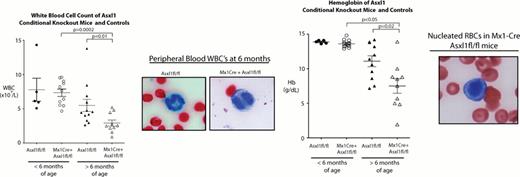Abstract
Abstract 308
Loss-of-function somatic mutations in Addition of Sex Combs Like 1 (ASXL1) occur in a subset of patients with myeloid malignancies, most commonly in myelodysplastic syndrome (MDS). In addition, germline mutations in ASXL1 are observed in patients with Bohring-Opitz Syndrome, a developmental disorder characterized by neurologic and skeletal abnormalities. Previous work characterizing a constitutive gene-trap Asxl1 model was notable for significant perinatal lethality of Asxl1−/− mice with evidence of an overt hematopoietic phenotype in surviving mice. Given the lack of detailed data on the hematopoietic phenotype of Asxl1 loss in vivo, we created a murine model for conditional knockout of Asxl1 for tissue- and temporal-specific deletion with 4 different Cre recombinase alleles.
We crossed our conditional Asxl1 allele to EIIa-cre to generate mice with germline loss of Asxl1; this revealed embryonic lethality of mice with homozygous germline Asxl1 loss. Mice with heterozygous germline deletion of Asxl1 were viable and fertile although a significant proportion had cranio-facial abnormalities. Timed-sacrifice of pregnant mothers from heterozygous EIIa-cre Asxl1+/− crosses revealed that homozygous Asxl1−/− pups survived to 18–20.5 days post-coitus, with all embryos characterized by craniofacial abnormalities including anopthalmia, microcephaly, cleft palates, and mandibular malformations similar to those seen with Bohring-Opitz syndrome.
We then generated mice with conditional Asxl1 deletion in the hematopoietic compartment by crossing floxed mice with Vav-cre recombinase mice for hematopoietic deletion at birth, and with Mx1-cre mice for inducible deletion of Asxl1. Deletion of Asxl1 in both systems resulted in complete loss of Asxl1 as assessed by Western blot. In both models we noted progressive development of leukopenia and anemia in mice with homozygous loss of Asxl1 compared to age-matched controls (Figure). This was associated with extramedullary hematopoiesis and morphologic evidence of myeloid, erythroid, and megakaryocytic dysplasia, similar to that observed in human MDS (Figure). Flow cytometry revealed a progressive increase in immunophenotypically-defined multipotent progenitors (Lineage-negative, Sca1+, cKIT+, CD150-, CD48+ cells) in bone marrow and spleen of knockout (KO) mice. Characterization of HSC's from 6-week old Vav-cre Asxl1−/− mice using serial competitive transplantation revealed a competitive disadvantage with transplantation of SLAM+ cells from 6-week old KO mice. A subset of Vav-cre Asxl1−/− mice developed a transplantable, monocytic-like leukemia beyond 6 months of age which was characterized by both proliferative and dysplastic features. Restriction of Asxl1 deletion to the megakaryocytic compartment using Pf4-cre revealed an age-specific decline in platelet production in Pf4-cre Asxl1−/− mice compared to age-matched controls, and a concomitant increase in bone marrow megakaryocytes in KO mice.
Consistent with previous in vitro studies, hematopoietic-specific deletion of Asxl1 was associated with a marked decrease in H3K27me3 as assessed by histone Western blots of murine splenocytes and H3K27me3 ChIP-Seq of myeloid progenitors from 1 year-old Vav-cre Asxl1−/− mice compared with littermate controls. RNA-Seq from myeloid progenitors was integrated with H3K4me3/K27me3 ChIP-Seq to identify gene targets of Asxl1 loss associated with myelodysplasia.
Given that MDS patients frequently present with concomitant ASXL1 and TET2 mutations, Vav-cre Asxl1fl/fl mice were also crossed with mice bearing floxed alleles of Tet2. Mice with combined hematopoietic-specific deletion of both Asxl1 and Tet2 developed bone marrow failure and hastened death compared with age-matched, single-gene deleted counterparts at 25 to 40 weeks of age.
The findings here reveal that hematopoietic-specific deletion of Asxl1 results in progressive ineffective hematopoiesis, an increase in hematopoietic progenitors, a propensity for leukemic transformation with age, and morphologic features of human MDS (Figure). Combining Asxl1 deletion with loss of Tet2, a combined genotype present in at least 5% of patients with de novo MDS, resulted in shorter latency, progressive MDS. These data suggest that these two models represent novel, genetically accurate models of MDS amenable to epigenomic, functional and preclinical therapeutic studies.
No relevant conflicts of interest to declare.
Author notes
Asterisk with author names denotes non-ASH members.


This feature is available to Subscribers Only
Sign In or Create an Account Close Modal